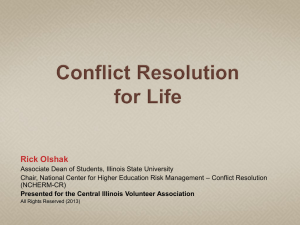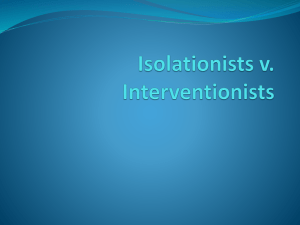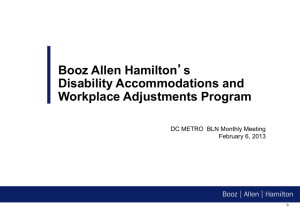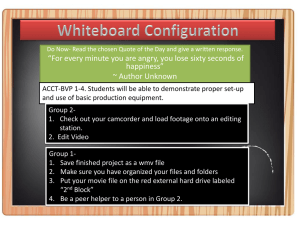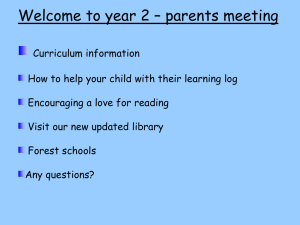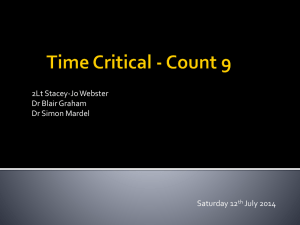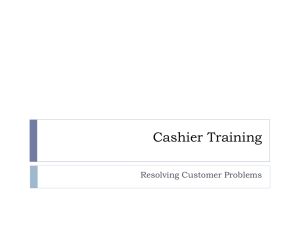Conflict Resolution (PPT 1.00 MB)
advertisement
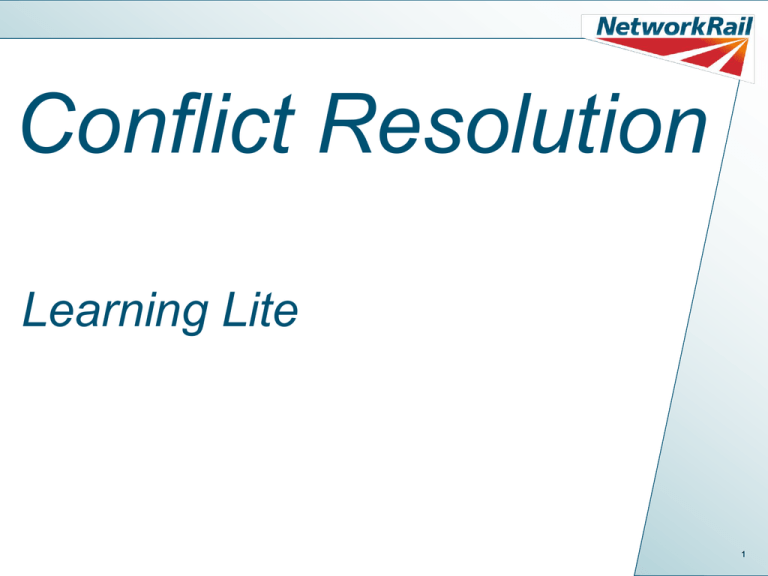
Conflict Resolution Learning Lite 1 Who me? • We all experience conflict every day, with family or friends; coworkers or customers • Since conflict will occur, what is important is how we understand, resolve and learn from it • A conflict is not a battle, there does not have to be a loser • There are techniques than can be used to work through a conflict successfully so everyone is a winner • Focus must remain on personal safety and professionalism 2 Why Conflict Resolution Training? • To; • Understand the affect conflict has on you • Recognise when it is appropriate to communicate with an angry person using a range of techniques • Understand how to diffuse negative encounters and make a positive out of a negative • Learn how to speak with others about uncomfortable or potentially “hot topics” and maintain a professional approach • Understand the motivators to violence and understand how and why colleagues become angry • Recognise when it is no longer safe to communicate and the only safe response is to walk away 3 Mirror Mirror…On the wall… People are mirrors Our response to others is often dictated by how they approach us. To flip that on it’s head…think about; • How do you approach others? • Do you respect other people’s opinions? • What makes you angry? • What are the warning signs of your anger? • What do you do… do you walk away or do you take a moment or do you explain that you need to continue the discussion later, or do you agree with the other person and “give in”? 4 Clues – agitation and aggression Do you recognise when someone is becoming irritated or is your first clue someone shouting at you or storming off? • Some other clues for you; • Voice changes pitch • Skin tone flushes or goes pale • Breathing rate changes • Tense body posture • Eye contact changes – either more direct and challenging or avoiding eye contact completely 5 What do people do? Five basic ways of addressing conflict were identified by Thomas and Kilman in 1976: • Avoidance • Collaboration • Compromise • Competition • Accommodation ALWAYS CONSIDER WHETHER THE SITUATION INVOLVES SAFETY RELATED ISSUES AND MODERATE YOUR RESPONSE ACCORDINGLY We will explore each of these in brief over the next few slides 6 Avoidance What does it look like? Avoid or postpone conflict by; • Ignoring it • Not rising to it Respecting that everyone has different opinions Asking to talk about it later, when it’s less busy (for example) When to use it? • For minor – non-recurring conflicts Potential outcomes • Ignoring negative verbal behaviours can diffuse situations • May exacerbate situations Consider • Is a conversation required? • is this actually a pattern involving the same individuals? • If this is a pattern - do you need support? 7 Collaboration What does it look like? • Working together to find a mutually beneficial solution When to use it? • As part of problem solving • In meetings or 1:1 Potential outcomes • Win-win solutions to conflict or disagreement Consider • How much time you have available and how well you know those you are speaking with • How to use your questioning skills to capture everyone’s requirements • How to gain agreement before continuing 8 Compromise What does it look like? • Finding a middle ground in which each party is partially satisfied When to use it? • As part of problem solving • When the time to collaborate effectively is not available • When the situation is less complex Potential outcomes • The key requirements or expectations of those involved may be resolved Consider • Will those involved be satisfied with a partial solution • How to use your questioning skills to capture requirements • How to gain agreement before continuing 9 Competition What does it look like? • Asserting your viewpoint at the potential expense of those involved When to use it? • Rarely Potential outcomes • You may appear aggressive or arrogant • Poor working relationship Consider • Why would your viewpoint be any more correct or relevant than anyone else’s? • What you could ask those involved in order to understand the situation better? • How do you react when someone overrides your opinion? Note It is almost always best to ask questions and get an understanding of context before offering an opinion 10 Accommodation What does it look like? • Surrender your own needs and wishes to accommodate the other party When to use it? • If this will achieve the best outcome Potential outcomes • A short term solution that you can live with • If you are the one accommodating, then over time, you might resent working in this way Consider • Why would your viewpoint be any less correct or relevant than anyone else’s? • What the circumstance is • Do you need to build a working relationship? • Are you choosing to do this because of hierarchy? • What you could ask those involved in order to understand the situation better? 11 Tool box tools and techniques Empathy • Walk a mile in the other person’s shoes (figuratively speaking) Active listening • Use good eye contact, body posture, nodding and acknowledgement when someone is talking to you • Summarise and paraphrase what you hear and repeat it back without changing language styles to make sure you are on the same page and understand what has been said Take your time • Give the other person time to respond and space to do so • No matter how thin you slice it – there are always 2 sides • Remember respect cuts both ways Open Questions • What, Where, How, Who (be careful of why as “why” questions can start to feel like an interrogation) 12 Do…. Empathise with them • The focus of your listening is to understand the other party – for you to “get it” • Work to let them know what it is you “got” • Use communication skills such as – paraphrasing and summarising • Use the same sorts of words they • are using (not the expletives) • Check your understanding • Acknowledge what has been said 13 Do…. Listen • This is not the easiest thing to do, especially on those occasions when you are bursting to give someone a piece of your mind! • Work to show that you are focused on understanding the other person’s point of view. • Focus on the words you choose, your tone of voice, your hand movements and body language • Always show respect • No matter how much you disagree with someone – your challenge is with the subject, context, circumstance or argument NOT with the person Consider • How does it affect you, when you do not feel you are being listened to…someone stands over you…raises their voice….speaks over you….wags their finger at you….tells you off? 14 Do….Take your time • The only person you can control is you • If you start to get angry take a break to reduce your emotional level and give you a chance to think about how to handle the situation • Ask questions and keep an open mind 15 Do….Explain with care • How can you do this when your point of view is very different from theirs? • Use “I” statements rather than “you” statements • Instead of “you don’t know what you’re talking about” try “I’d like to explain my perspective to you” • Blaming and judging people is not helpful and will not effectively find a solution • Avoid discussing attitudes and personalities 16 Do….think creatively • Use the different methods explored here • Work to identify different solutions from those so far rejected by one of the parties 17 And Finally…. • Accept the situation • Conflict cannot always be avoided • Not all conflict is negative 18 And Finally…. Accept the situation • Conflict is not mathematics • There is not always a solution waiting to be found • If there is a solution – it is very unlikely to be the only one 19 And Finally…. Conflict cannot always be solved or avoided The Swiss psychologist Carl Jung once wrote that “the greatest and most important problems of life are all fundamentally insoluble. They can never be solved but only outgrown” 20 And Finally…. Not all conflict is negative • Although this learning lite presentation is about resolving conflict, be aware that conflict cannot always be avoided (especially when fundamental differences, as opposed to perceived difference, are involved) • Not all conflict is negative (sometimes it “clears the air”) • The important thing is to keep wasteful and damaging conflict to a minimum and when it does occur, use the techniques to resolve or at least ease it 21 What did we learn? • We all experience conflict every day • Approaches to Conflict Resolution include; • Avoidance • Collaboration • Compromise • Competition • Accommodation • Win Win solutions build relationships and aid solutions • Conflict is not mathematics • There is not always a solution waiting to be found • If there is a solution – it is very unlikely to be the only one 22

